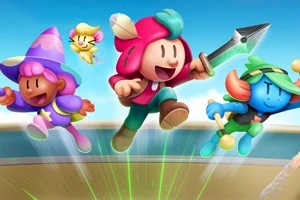Feature: Did The Smash Bros. Brawl Dojo Work?

Posted 26 Jun 2008 at 23:07 by Tom Phillips

Epic undertaking or boring blog? We ask, did the Brawl blog work? Head inside to find out - and to let us know your opinions...
Written by Mark "Tapedeck" Lee
From knowing who is going to buy your product to picking a time of release, marketing games isn’t the easiest thing in the world. With Super Smash Bros Brawl, Nintendo didn’t need to worry about finding their audience or picking a launch window (in the EU at least!) For a franchise as large as Smash Bros., fans would be queuing with their money ready regardless. So the Smash Bros DOJO!! (or Sumabura Ken!! in Japanese) was initially a strange venture for such a massive title. Join N-Europe as we take a stroll down memory lane to see if the Dojo was a success or one big poison mushroom...
HISTORY OF THE SMASH DOJO:
If you’re to believe Masahiro Sakurai (creator of Smash Bros. and blogger-extrodinaire at the dojo), and we do, the whole thing was started as a means to convey Brawl developments to rabid fans the world over. Dojo is obviously a Japanese term which, when translated literally, means "place of the way". Dojo are usually used as a means for combatants to fight/train or take their exams in. A fitting title then for the blog.
Perhaps thought of by many as a ‘new’ idea, the Dojo actually stems from Sakurai’s previous personal blog for Smash Bros. Melee (http://www.nintendo.co.jp/n01/n64/software/nus_p_nalj/smash/flash/index.html). Sakurai wrote this blog alongside the development of Brawl's predecessor on the Gamecube and it is no wonder that it became a love letter to that title. Sakurai would answer Japanese fan queries and generally maintain the site on his own. Nothing like tooting your own horn amongst a forum full of fans. (Just ask some of our N-Europe staff!)
As development ended on Melee, Sumabura Ken!! continued to prove a popular haunt for Japanese players. So, in a way, it was no surprise that on May 22nd 2007 Sakurai picked up the blogging bug all over again when starting to develop Brawl for the Wii. Yet (probably) under the instruction of Nintendo, this was to become something much, much more this time around.

The man himself - Masahiro Sakurai.
CREATING EQUAL GROUND:
Every weekday, new information on Brawl was to be drip fed from the Dojo – thus bypassing the usual media publications. The Dojo actually went on for nearly a year (ending on April 14th 2008) and websites, journalists and fans alike camped out with their refresh buttons at the ready as they awaited the impending information. It created equality amongst everyone waiting for Brawl news and as this kind of ‘advertising/publicity’ was previously unheard of, in today's landscape where corporate-speak press releases are the order of the day.
It was really was a refreshing change, and this blogging method has since proved extremely popular. Websites such as IGN now feature regular developer blogs on their site – although few are updated as regularly or as well as the Smash Bros. Dojo was.
Another factor in the Dojo's success and innovation was the fact that the site could be viewed in many different languages - including Japanese, American English, British English, German, French, Spanish, and Italian. Each language contained the same details taken from Sakurai’s Japanese blog (apart from release dates) yet the combined effort this took from within Nintendo must have been mammoth. (If only they could have translated the actual game as fast!) Such fan service, even for a title as big as Brawl, is rare.
SMASHING THE COMPETITION:
Looking back on the Dojo reveals many things. It may have been nothing but a one-way hype train building Brawl into the “best thing ever”, yet we think there was actual heart involved. Thanks to its humble beginnings, we believe Sakurai actually enjoyed the universal media equality and all-round discussion the Dojo caused.
Sure there are the arguments that such a blogging system may have actually spoiled the final game in some regards - just by the sheer amount of data it holds. (Even though content was carefully released and to this day the secret characters are still hidden away on the site to protect those who don't wish to know who they are.)
Yet it’s likeability and therefore success lies in the fact that people still talk about it now - like it is an actual part of Brawl. And those waiting for Brawl enjoyed the daily log-on and subsequent discussion. Everytime a stage, character or even item was revealed the internet instantly flew into discussion. Few blogs have the ability to create such an influx of opinion. Few blogs feel as missed.
And it seems the Dojo idea is here to stay. Look at the articles entitled “Iwata Asks” and you will begin to see a refreshing openness creeping into Nintendo. It may smack of Western business ideals - against which Nintendo still keeps many of its doors shut, but at last we are now seeing the employees peeking outwards.
So, did the dojo fail? We feel a resounding no is in order. In fact, it may have far reaching implications for the future of all videogame development. But we’d like to point out that without the dedication of it’s readership (that’s you by the way) such an idea would never have worked out as well as it did.
Did you enjoy the Dojo blog as much as we did? Let us know in the comments below!
- Mark "Tapedeck" Lee
N-Europe Staff Writer






















